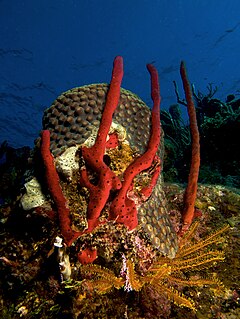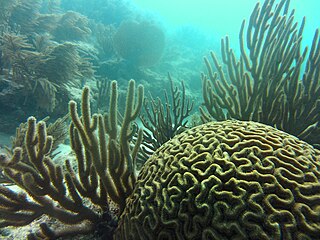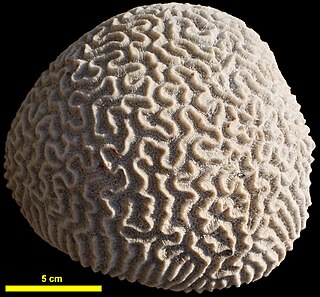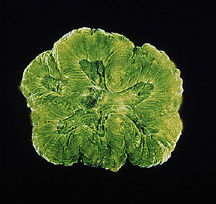
Pillar coral is a hard coral found in the western Atlantic Ocean and the Caribbean Sea. It is the only species in the monotypic genus Dendrogyra. It is a digitate coral -that is, it resembles fingers or a cluster of cigars, growing up from the sea floor without any secondary branching. It is large and can grow on both flat and sloping surfaces at depths down to 20 m (65 ft). It is one of the few types of hard coral in which the polyps can commonly be seen feeding during the day.

Mithraculus sculptus, the green clinging crab or emerald crab, is a species of crab in the family Majidae. It is a dark green colour and is found in tropical waters in the Caribbean Sea. It is sometimes kept in reef aquaria.

Porites astreoides, commonly known as mustard hill coral or yellow porites, is a colonial species of stony coral in the family Poritidae.
Arturia canariensis, commonly known as the yellow calcareous sponge, is a species of sponge in the family Clathrinidae. It is found in shallow seas in the Canary Islands, Cape Verde, the Adriatic Sea and the Caribbean Sea. The specific epiphet "canariensis" was given to this species because it was first described from Lanzarote in the Canary Islands.

Amphimedon compressa, the erect rope sponge, red tree sponge, red tubular sponge, or red sponge is a demosponge found in southern Florida, the Caribbean Sea, and the Bahamas. It can be deep red, orange, brown, or black.

Eusmilia is a genus of stony coral in the family Meandrinidae. It is a monotypic genus represented by the species Eusmilia fastigiata, commonly known as the smooth flower coral. It is found on reefs in the Caribbean Sea.

Umimayanthus parasiticus, commonly known as the sponge zoanthid, is a species of coral in the order Zoantharia which grows symbiotically on several species of sponge. It is found in shallow waters in the Caribbean Sea and the Gulf of Mexico.
Cliona delitrix is a species of burrowing demosponge belonging to the family Clionaidae. It is found in shallow water in the Caribbean Sea and the Gulf of Mexico.
Siderastrea radians, also known as the lesser starlet coral or the shallow-water starlet coral, is a stony coral in the family Siderastreidae. It is found in shallow parts of the western Atlantic Ocean as small, solid mounds or encrusting sheets.
Agelas schmidti, commonly known as the brown tubular sponge, is a species of demosponge. It occurs at moderate depths in the Gulf of Mexico and the Caribbean Sea and often has a colonial coral growing over the surface. The type locality is Puerto Rico.

Parazoanthus swiftii, commonly known as the golden zoanthid, is a species of coral in the order Zoantharia which grows symbiotically on several species of sponge. It is found in shallow waters in the Caribbean Sea and western Atlantic Ocean.
Neofibularia nolitangere, commonly known as the touch-me-not sponge, is a species of sea sponge in the family Biemnidae. It is found in shallow waters in the Western Atlantic Ocean and the Caribbean Sea.

Pseudodiploria strigosa, the symmetrical brain coral, is a colonial species of stony coral in the family Faviidae. It occurs on reefs in shallow water in the West Atlantic Ocean and Caribbean Sea. It grows slowly and lives to a great age.

Pseudodiploria clivosa, the knobby brain coral, is a colonial species of stony coral in the family Mussidae. It occurs in shallow water in the West Atlantic Ocean and Caribbean Sea.

Gorgonia ventalina, the purple sea fan, is a species of sea fan, an octocoral in the family Gorgoniidae. It is found in the western Atlantic Ocean and the Caribbean Sea.
Aplysina insularis, commonly known as the yellow-green candle sponge or yellow candle sponge, is a species of sea sponge found on reefs in the Caribbean Sea and the Gulf of Mexico.

Porites porites, commonly known as hump coral or finger coral, is a species of stony coral in the genus Porites. It is found in the Caribbean Sea and western Atlantic Ocean and also along the coast of West Africa.

Plexaurella nutans, the giant slit-pore sea rod, is a tall species of soft coral in the family Plexauridae. It is a relatively uncommon species and is found in shallow seas in the Caribbean region.

Isophyllia sinuosa, the sinuous cactus coral, is a species of stony coral in the family Mussidae. It is found in shallow water in the tropical western Atlantic and the Caribbean Sea.

Mussa is a genus of stony coral in the family Mussidae. It is monotypic, being represented by the species Mussa angulosa, commonly known as the spiny or large flower coral. It is found on reefs in shallow waters in the Caribbean Sea, the Bahamas and the Gulf of Mexico.













